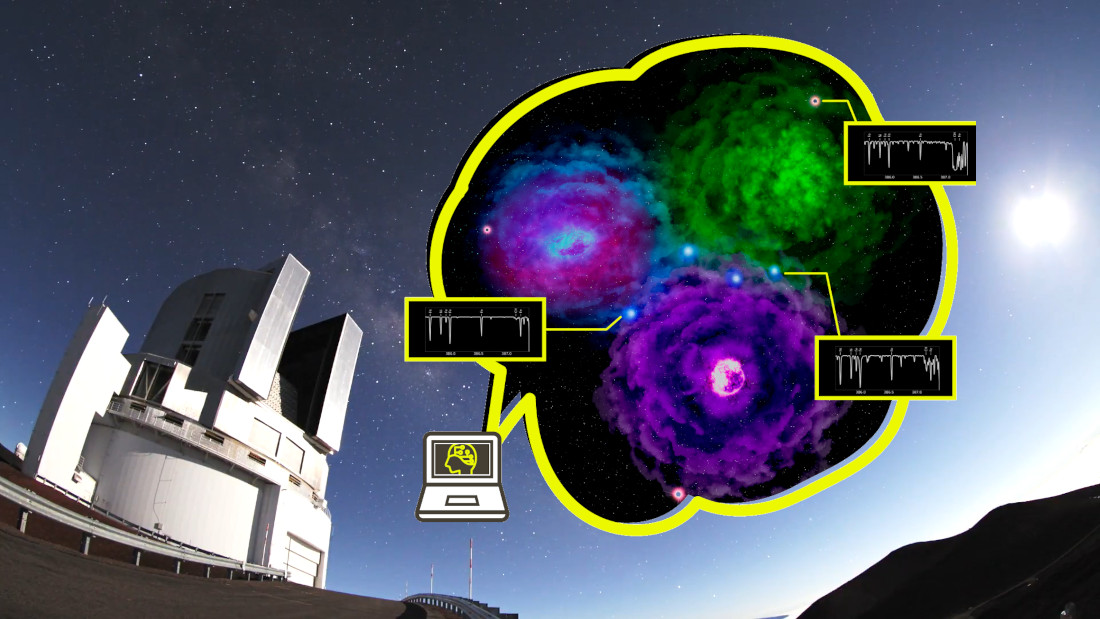(BIVN) – Artificial intelligence has helped an international team using the Subaru Telescope on Maunakea see “indications that the very first stars in the universe were born in groups rather than as isolated single stars.”
From a Subaru Telescope news release:
Astronomy seeks to explain the history of the universe — from its beginnings to the formation of our solar system and more. Subaru Telescope continues to lead the way to help find the answers to puzzling astronomical questions through state-of-the-art technologies.
In a recent discovery, an international team used artificial intelligence to analyze the chemical abundances of old stars and found indications that the very first stars in the universe were born in groups rather than as isolated single stars.
“Our new technique based on machine learning opens the door to study the mysterious nature of the first stars in the universe,” explains Subaru Telescope assistant professor Miho Ishigaki.
Subaru Telescope has a tremendous advantage in observing a wide field of view with high spatial resolution in visible light. Currently, the Hyper Suprime-Cam (HSC) mounted on the prime focus at the top of the telescope offers an ultra-wide field view. Soon, Subaru Telescope will also add the Prime Focus Spectrograph (PFS) on the telescope’s prime focus. With PFS, telescope will have 50 times the field of view and 20 times the number of simultaneous spectroscopic objects compared to other conventional instruments.
“Multi-object spectrographs on large telescopes, such as the Prime Focus Spectrograph (PFS) on the Subaru Telescope, can find old stars in previously unexplored outer portions of the Milky Way,” explains Ishigaki. “Our technique can use the data we collect to put constraints on the complex nature of the formation of the first stars and explain their role in the early universe.”
The nature of how the first stars in the universe were formed is still unknown, and since it is not possible to directly observe the first stars, astronomers extract information from the chemical compositions of old stars in the Milky Way. After the Big Bang, the only elements in the universe were hydrogen, helium, and lithium. Most of the other elements making up the world we see around us were produced by nuclear reactions in stars. Some elements are formed by nuclear fusion at the core of a star, and others form in the explosive supernova death of a star. Supernovae also play an important role in scattering the elements created by stars, so that they can be incorporated into the next generation of stars, planets, and possibly even living creatures.
“In our study, we address the question of whether the first stars were more likely born in isolation or as multiple stellar systems such as binary stars or star clusters,” says Ishigaki. “To this end, lead author Tilman Hartwig invented a machine-learning algorithm to distinguish between the observed stars formed out of the ejecta of a single supernovae (shown in red in the diagram) and stars formed out of ejecta from multiple supernovae (shown in blue in the diagram), based on measured elemental abundances from the spectra of the stars.”
The first generation of stars in the universe — the first to produce elements heavier than lithium — are of particular interest. But first-generation stars are difficult to study because it is thought that they have all already exploded as supernovae. So, researchers try to draw inferences about first-generation stars by studying the chemical signature the first generation of supernovae imprinted on the next generation of stars.
In this study, a team including members from the University of Tokyo/Kavli IPMU, National Astronomical Observatory of Japan, and University of Hertfordshire took a novel approach of using artificial intelligence to interpret elemental abundances in over 450 extremely metal-poor stars observed by telescopes including the Subaru Telescope. They found that 68% of the observed extremely metal-poor stars have a chemical fingerprint that is consistent with enrichment by multiple previous supernovae. Now the team hopes to apply this method to Big Data from current and future observing programs, such as the data expected from the Prime Focus Spectrograph on the Subaru Telescope.
These results appeared as Hartwig et al. “Machine Learning Detects Multiplicity of the First Stars in Stellar Archaeology Data” in The Astrophysical Journal on March 22, 2023.
About Subaru Telescope
The Subaru Telescope is an 8.2 meter optical-infrared telescope at the summit of Maunakea, Hawai‘i. It is operated by the National Astronomical Observatory of Japan (NAOJ), National Institutes of Natural Sciences (NINS). One of Subaru Telescope’s main missions, in addition to telescope operations and astronomical discoveries, is to foster education in the next generation of researchers. The observatory of Subaru Telescope was officially established in April 1997.


by Big Island Video News6:59 am
on at
STORY SUMMARY
MAUNAKEA, Hawaiʻi - New techniques based on machine learning "opens the door to study the mysterious nature of the first stars in the universe", astronomers say.